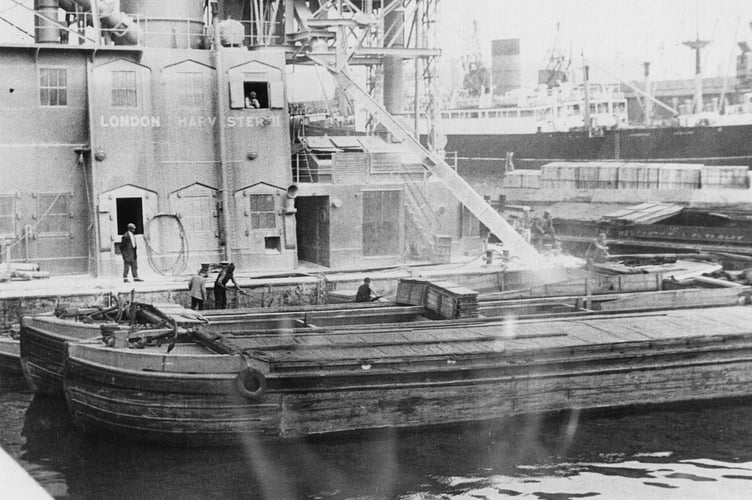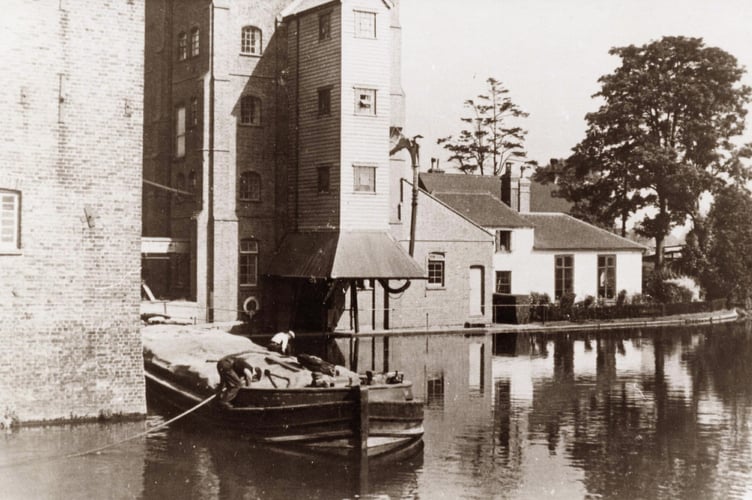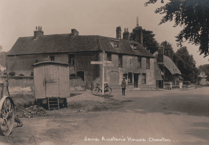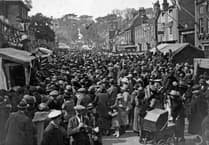It may come as a surprise, but there were commercial barges on the River Wey Navigation still being pulled by horses as late as 1969.
This at the same time that more and more freight was going by road, and even after the withdrawal of steam trains on the Southern Region of British Railways in 1967!
However, when these barges reached Thames Lock at Weybridge and entered the Thames, they were drawn by powered tugs down to the Port of London and back again.
These photos feature Wey barges as they neared the end of their life on sections of the Thames and at Coxes Mill at Addlestone. By this time the cargo was mostly wheat from North America.

Former Wey bargeman John White has recalled for the National Trust River Wey Navigations (that today looks after the waterway) details of trips he made to and from the London docks.
These included the Surrey Commercial Docks at Rotherhithe and the Central Granaries in Millwall, which was part of the West India Dock.
John remembers the Royal Victoria Dock was very deep, which caused problems for some boats, but the Wey bargeman coped with it well.
What was known as the London Harvester II was a huge piece of machinery that sucked grain out of the docked ships and pumped it straight into the barges. Timber was loaded directly from ship to barge.
On returning and closer to the Wey Navigation, the powered tugs towing the barges soon took the channel known as Desborough Cut. It was created by the Thames Conservancy in the 1930s and saved river traffic time by not having to circumvent the large bend of the natural Thames near to Shepperton.

The cut is a similar width to the natural river and halves the distance of travel from its start to its finish. It also helps to alleviate flooding at Hamm Court and in Shepperton. It resulted in the creation of the 112-acre Desborough Island in the Thames.
The island and cut are named after Lord Desborough, a former chairman of Thames Conservancy.
Today the island has a number of public footpaths around and across it, as well as playing fields that are home to Weybridge Vandals Community Sports Club and a Thames Water treatment works.
The original Coxes Mill at Addlestone appears to have been constructed around the 1770s by an Alexander Raby and his business partner Obadiah Rogers. It appears the original mill was used to form iron into hoops for wooden casks.
Some time after 1829 a Daniel Lambert built a corn mill on the site that was also used to manufacture silk. It passed into new ownership at the start of the 20th century and a tall roller mill and silo were added.

These details are mentioned in the book The Wey Navigations, A Historical Guide, published in 2003. The author, Alan R Wardle, writes that for more than 60 years William Stevens & Sons’ barges supplied Coxes Lock Milling Company Ltd with wheat, in 80 to 90-tonne barges from the London Docks.
Four or even six barges lashed together would be towed up the Thames by tug to Weybridge and then by horse to Coxes Mill. There the bulk cargo was transferred by suction into the silo. By the 1960s this was almost the only commercial traffic remaining on the Wey Navigation.
On July 3 and 4, 1969, barges Perseverance IV and Speedwell were the last two Stevens’ barges to be unloaded at the mill. Both survive to this day. Perseverance IV is undergoing conservation work on dry land beside Stoke Lock, Guildford.
Speedwell has been at the National Waterways Museum at Ellesmere Port in Cheshire since 1982, and it is reported that currently it is off-site and in storage.





Comments
This article has no comments yet. Be the first to leave a comment.